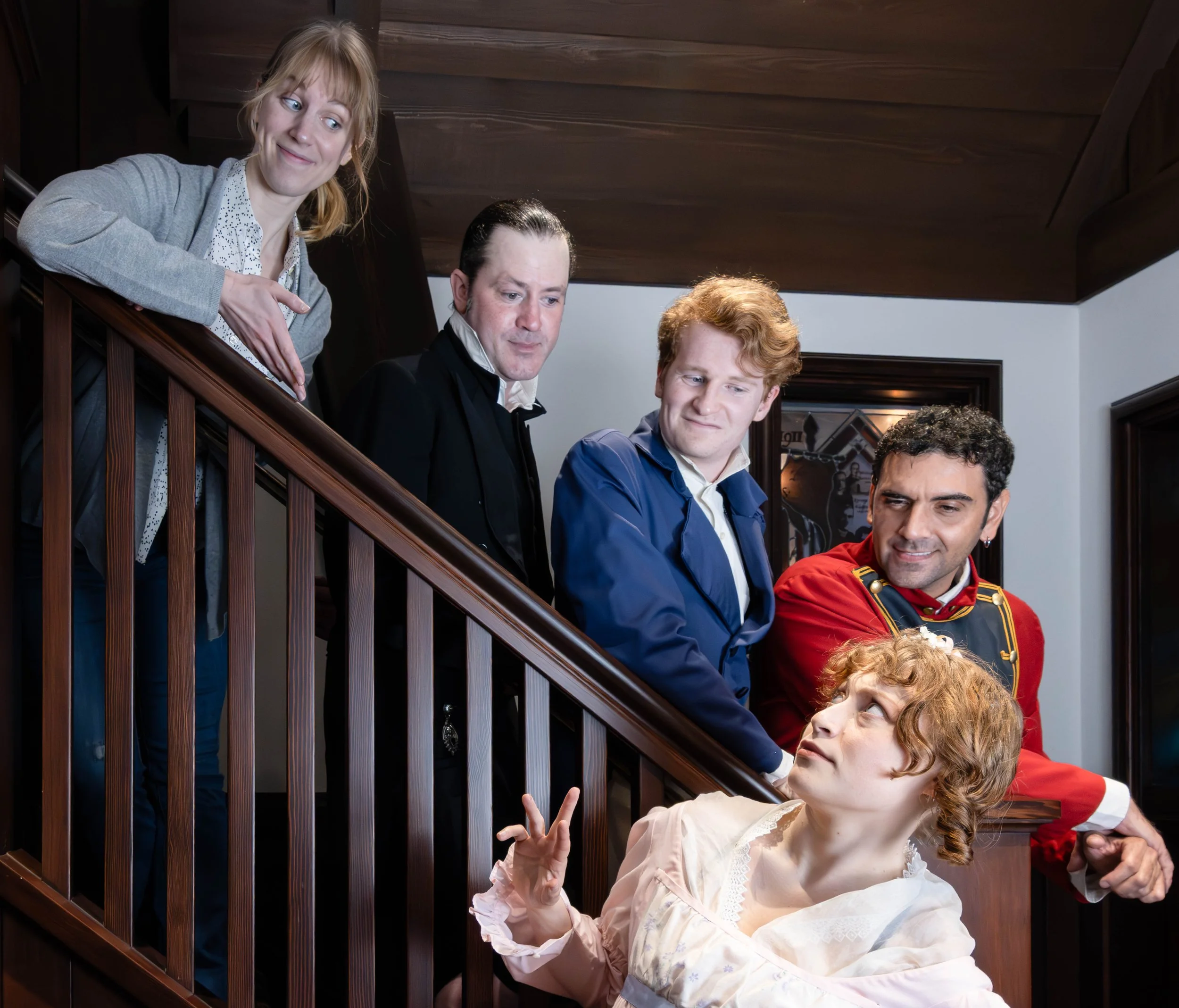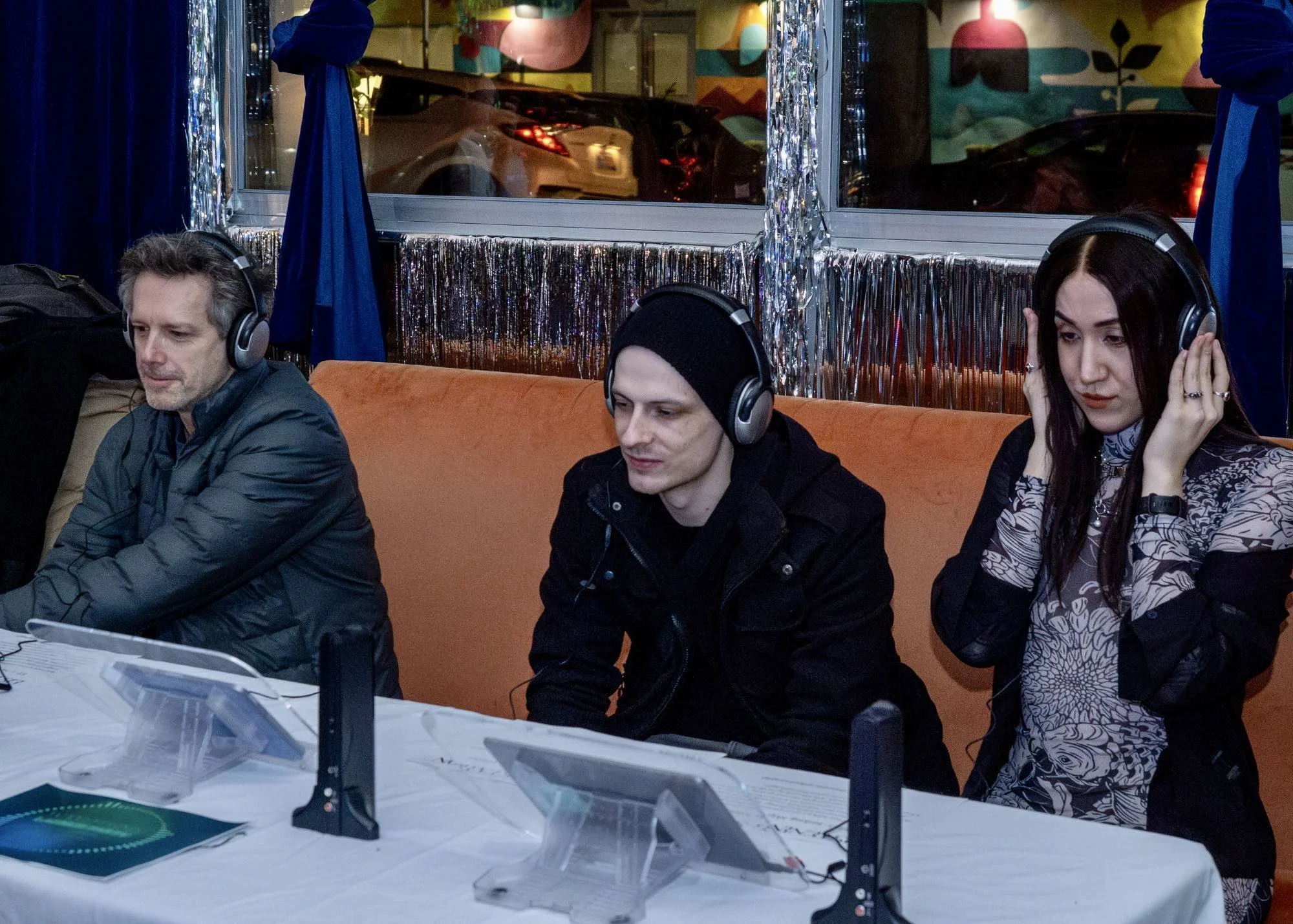Stir Q&A: The Watsons breathes new life into an unfinished Jane Austen manuscript
At Vital Spark Theatre, Joan Bryans directs the adaptation that explores what could happen if the characters decide their own fates
(Clockwise from left) The Watsons actors Claire deBruyn, Matt Loop, Sam Walmsley-Byrne, Diego Morelli, and Bracha Burke. Photo by Nancy Caldwell
Vital Spark Theatre presents The Watsons at the Jericho Arts Centre from May 2 to 18
MENTION THE NAME Jane Austen, and most people think Pride and Prejudice or Sense and Sensibility. But equally as intriguing are the beloved English novelist’s unfinished works.
One such abandoned project is The Watsons. About 80 pages long, the posthumously published manuscript follows Emma Watson, a well-educated young woman who was raised by her wealthy aunt and uncle. But when her uncle dies and her aunt remarries, Emma is sent to live with her father—who has also fallen ill. She and her three sisters must marry quickly in order to keep themselves financially afloat.
While there have been several interpretations of the story’s ending in the two centuries since it was written, no one is certain exactly how Austen would have wrapped it up. Playwright Laura Wade has taken a totally unique approach to The Watsons with her 2018 theatrical adaptation: she explores what might happen if the characters were fed up with all the plot speculation and began to carve their own paths.
Vital Spark Theatre will stage Wade’s version of The Watsons at the Jericho Arts Centre in May. Stir connected with Vital Spark’s artistic director Joan Bryans, who’s directing the show, to learn a bit more about it.
What do you think it is about the story of Emma Watson that grabs readers and makes them want to know more, despite Jane Austen’s incomplete novel? On a similar note, why did you choose to bring this production to life this year at Vital Spark Theatre?
The character of Emma is very appealing. She’s feisty, a free spirit, and, even at 18, knows her own mind. You want to see how she copes with the difficult situations she finds herself in.
I wanted to bring Laura Wade’s work to Vancouver because of the intriguing way she develops the story from the basis Austen. Rather than have a complete story to be presented, with characters all firmly set in their Austenian ways, Wade opens it up completely. She puts the playwright on the stage, hidden as the character of a maid, and has her try to manipulate the characters as she thinks they ought to go. But Austen’s characters, particularly Emma, are tough cookies, and not so easily manipulated. It is this have-it-happen-as-the-play-unfolds that particularly intrigued me about The Watsons. I couldn’t wait to have it unfold on stage in Vancouver.
For folks who might not be as familiar with The Watsons, how does it compare to some of Austen’s more well-known novels, like Pride and Prejudice or Sense and Sensibility? Within that context, how would you describe Emma Watson as a character?
There are many familiar Austen themes and situations in The Watsons—at least at first. There are young women suddenly thrust into threatening financial circumstances where the only solution seems to be to get married to someone, anyone, who will support them. Emma is different. She stands out from the other young women in the play; she is independent and inquisitive. She doesn’t want to get married. She may be forced to, but won’t go easily.
There have been a few different interpretations of the ending of The Watsons published over the years, including by Austen’s own niece. What would you say makes Laura Wade’s take on the story unique? Without giving too much away, can you expand on how it gives the characters autonomy or satisfies some of the loose ends in the novel?
There have been many attempts to finish The Watsons over the years. The idea always has been to try to continue the work as if Jane Austen wrote it. Personally, I don’t think they work—no one can write like Austen! Wade’s work is quite different. It is the first time the work has been made into a play, and she uses the dynamics of the immediacy of the stage to create the story as the play progresses. The characters are given free rein to develop themselves. We see the story of The Watsons being developed on the stage as it progresses.
How do elements like Todd Parker’s set design and Catherine Carr’s costumes help transport the play and viewers to 19th-century England? Visually speaking, what excites you about capturing that era onstage at the Jericho Arts Centre?
It is a very romantic era, and Catherine’s costumes capture it completely. So too does Todd’s set. He faced some technical challenges—I loved one stage direction in the script: “Elizabeth appears, bringing the parlour with her.” Great when you can fly in a new backdrop or turn a revolve. Not quite so easy at Jericho. More challenges appear when the characters become more autonomous and the world spins in many directions, but Todd and our lighting designer Jack Mosher were well up to the challenge.
What aspect of directing The Watsons has been the most enjoyable for you so far? How do you think this story will appeal to audiences?
It has been such a delight to watch the cast get to grips with Austen’s wonderful characters. There are some terrific actors in the cast—and to see them grow into these eccentric characters and make them their own, and see the dynamic that happens between them, leads to a very exciting show. It is the kind of show that given the freedom the characters have, you have no idea what is going to happen next.
The story is very unpredictable. I love that, and I think audiences will too. I also think that the main story of a young girl battling her way through all sorts of weird obstacles and coming out on top is very satisfying. Her journey is very appealing. ![]()

























